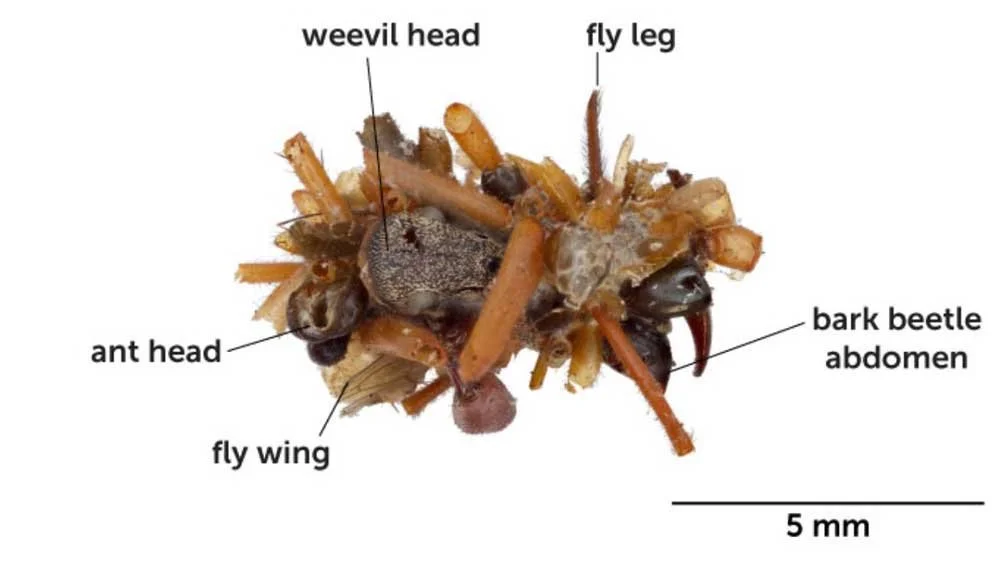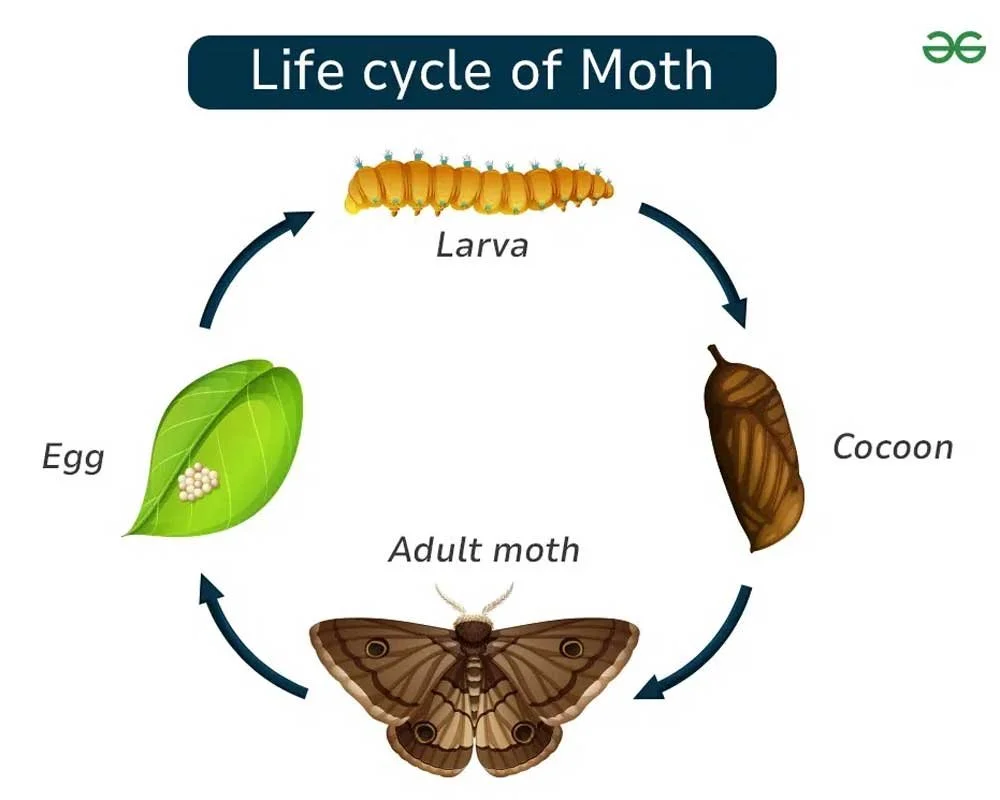The Bone Collector Caterpillar
Where did scientists discover a creepy, clever, and one-of-a-kind insect?
Caterpillars that decorate their cases do so with leaves or bark. What does this caterpillar decorate its case with?
The “bone collector” caterpillar is a member of what group of Hawaiian insects? (Hint: The name is in italics!)
Which natural enemy do bone collector caterpillars live among?
How does a bone collector caterpillar’s “camouflage coat” keep it safe?
Why do bone collector caterpillars live by themselves?
Describe the life cycle of a moth. (Hint: Look at one of the diagrams!)
Which mountains on Oʻahu was Dr. Dan Rubinoff walking through when he found the bone collector caterpillars?
Where on Oʻahu are these mountains?
How is the bone collector caterpillar in danger?
• Read •
The Bone Collector Caterpillar
The Bone Collector Caterpillar
In the forests of Oʻahu, Hawaiʻi, scientists have discovered a creepy, clever, and one-of-a-kind insect. It's a caterpillar that not only eats other insects—it wears them.
Yes, really.
This caterpillar lives inside a soft, silk case that it carries with it. But instead of decorating the case with leaves or bark like other insects, it attaches bug body parts: wings, legs, heads, even spider skins. That’s why scientists gave it the nickname “the bone collector.”
This strange little creature has shocked scientists and amazed bug lovers all over the world. But it’s also in danger of disappearing forever.
A Caterpillar Like No Other
The bone collector caterpillar is a member of a group of Hawaiian insects called Hyposmocoma. These are known as “fancy case caterpillars” because they build and wear tiny homes made of silk.
Most Hyposmocoma species eat plants. But the bone collector is different. It is a meat-eater, or carnivore.
Even weirder, it lives in a very risky place—spider webs.
• Caterpillar on left, spider on right
That’s right. This caterpillar makes its home among spiders, one of its biggest natural enemies. It doesn’t just visit the web. It stays there, hides there, and hunts there.
How does it survive? It uses its spooky outfit made of leftover bug bits to blend in. This disguise helps it trick the spider and sneak past unnoticed.
A Bug-Eating Bug in Disguise
The bone collector caterpillar doesn’t catch its own prey. Instead, it watches and waits in the spider’s web for a meal to appear. If a bug gets trapped in the sticky silk, the spider usually gets to it first. But the caterpillar may help itself to the leftovers.
Sometimes it even chews through the spider’s web to reach a dead insect.
To stay safe, the caterpillar covers its case with body parts from dead bugs.
It has been seen attaching fly wings, ant heads, beetle legs, and even shed spider skins. This “camouflage coat” helps it hide by smelling and feeling like everything else in the web. It may even confuse the spider into thinking the caterpillar is just another piece of junk.
Scientists say this is a “decorate-or-die” situation. Without its creepy costume, the caterpillar could become the spider’s next meal.
A Lonely Life Among Spiders
The bone collector caterpillar is usually found alone. Scientists have never seen more than one in the same spider web. Why? Because they’re also cannibals. That means they’ll eat each other if given the chance!
Once the caterpillar has eaten enough, it seals off its case and transforms into a moth. As an adult, it no longer wears a bug-covered coat.
The entire life of this caterpillar happens in a small, hidden world—inside tree holes, fallen logs, or cracks in rocks where spiders spin their webs.
A Rare and Ancient Discovery
The bone collector caterpillar was first seen in 2008 by Dr. Dan Rubinoff, a scientist at the University of Hawaiʻi at Mānoa. He found it while walking in the Waiʻanae Mountains of Oʻahu.
• Map of the Waiʻanae mountains and the northwest section of Oahu.
It was hanging around a spider web and wearing bits of dead bugs.
At first, Dr. Rubinoff didn’t think much of it. But over the next 20 years, he and his team kept finding more of these unusual caterpillars. Not many—just 62 in all. And every single one was found within a tiny area of about six square miles.
DNA testing showed that the caterpillar’s family is at least six million years old—older than the island of Oʻahu itself. That means its ancestors probably lived on other Hawaiian islands that have since sunk into the sea.
In Danger of Disappearing
Even though this caterpillar is clever and ancient, it’s in trouble.
Its home in the mountains is threatened by invasive ants, parasitic wasps, and climate change.
These dangers could wipe out the last members of this strange species. And because the caterpillar lives in such a small area and has such unusual habits, it’s not easy to protect.
The bone collector caterpillar has learned to live in a very risky world, depending on spiders for both food and shelter. But now it needs help from people to survive.
Scientists are calling for conservation efforts to save its forest home before it’s too late. Without action, the world could lose one of the weirdest, most wonderful caterpillars ever discovered.
Camouflage (n.) – something that helps a living thing blend into its surroundings
Cannibal (n.) – a creature that eats others of its own kind
Carnivorous (adj.) – meat-eating; feeding on other animals
Caterpillar (n.) – the larva stage of a moth or butterfly
Conservation (n.) – the act of protecting nature and the environment
Environment (n.) – the natural world around us, including plants, animals, and land
Evolution (n.) – the process by which living things change over time
Habitat (n.) – the place where an animal or plant lives
Invasive (adj.) – spreading in a way that causes harm, especially to the environment
Larva (n.) – the early form of an insect before it becomes an adult
Macabre (adj.) – strange or disturbing, especially because it is related to death
► COMPREHENSION QUESTIONS
— please answer with complete sentences
Where did scientists discover a creepy, clever, and one-of-a-kind insect?
Caterpillars that decorate their cases do so with leaves or bark. What does this caterpillar decorate its case with?
The “bone collector” caterpillar is a member of what group of Hawaiian insects? (Hint: The name is in italics!)
Which natural enemy do bone collector caterpillars live among?
How does a bone collector caterpillar’s “camouflage coat” keep it safe?
Why do bone collector caterpillars live by themselves?
Describe the life cycle of a moth. (Hint: Look at one of the diagrams!)
Which mountains on Oʻahu was Dr. Dan Rubinoff walking through when he found the bone collector caterpillars?
Where on Oʻahu are these mountains?
How is the bone collector caterpillar in danger?
► From EITHER/OR ► BOTH/AND
► FROM Right/Wrong ► Creative Combination
THESIS — Argue the case that animals should never live near their predators.
ANT-THESIS — Argue the case that animals can find ways to live near their predators.
SYN-THESIS — Find a way to bring these two perspectives together.

















